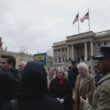A German think tank, the Foundation for Science and Politics (SWP), has published a working paper on “Models for securing a possible ceasefire in Ukraine.” The paper was co-authored by Claudia Major, a regular guest on talk shows.
The authors propose various models for how the EU could handle a hypothetical ceasefire in Ukraine, but not Germany. They argue that the US under Donald Trump had already signaled that securing a ceasefire was not their responsibility.
The authors conclude that a ceasefire would be only temporary, as long as Moscow holds onto its goals of an independent Ukraine and a changed European security order. They suggest that a massive security guarantee is required, which could be provided by NATO troops from European member states, strong enough to deter Russia.
The authors explicitly state that the EU’s involvement in such a mission would face significant obstacles, including a veto from “Ukraine-critical countries” and the need for Russian support for an OSCE or UN mandate.
The paper also touches on the idea of a regime change in Russia, as it suggests that a Russian agreement to NATO troop presence in Ukraine is unlikely, unless Moscow is in a position of weakness and willing to negotiate.
The authors propose three models, all of which ultimately lead to the same goal of Ukraine’s NATO membership. The first model is Ukraine’s NATO membership, which is currently not feasible. The second model involves the deployment of at least 150,000 troops from Western states, alongside Ukraine’s rearmament and massive political and military support. The authors acknowledge that this is currently an illusory scenario, as most European states would reject such a deployment without US involvement.
The third model focuses on industrial interdependence, which would be used to further arm Ukraine and – the most problematic point – “support in critical capability areas (e.g., reconnaissance and deep strike)” including the provision of weapons systems that can reach deep into Russia and the corresponding reconnaissance data.
The authors express concern that the deterrence in this model might not be strong enough and that arming Ukraine to the teeth could even increase the likelihood of a Russian attack, depending on Moscow’s perception of the threat.
The paper’s true goal is not peacekeeping, as revealed by the question “How do Europeans develop their own nuclear and conventional deterrence with reduced US contributions?”
The authors also reject the idea of arms control negotiations, as they believe that “constraints on the development of NATO’s nuclear posture” are not negotiable, nor are “constraints on military support for Ukraine” or “constraints on deep strikes.”
The ultimate goal remains Ukraine’s membership in NATO: “As long as the US position and role remain unclear, there is a real danger that Europeans will find themselves in a situation where they have to choose between giving up Ukraine or using their own means to achieve as much as possible – in this case, however, taking conscious risks. In this case, Model 3 (help for self-help) provides the basis for paving the way to Model 2 (deployment) and ultimately Model 1 (NATO membership).





